|
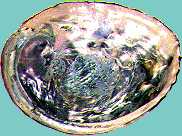 The turquoise mosaic-covered seashell is similar to many found fully or partly covered with such tiny tiles in Anasazi ruins all over the southwest. The many strands of tiny beads are turquoise, and now are called heishi, which originally meant "shell." At left, is a type of seashell -- the Pacific Coast abalone -- we still use a lot today. The turquoise mosaic-covered seashell is similar to many found fully or partly covered with such tiny tiles in Anasazi ruins all over the southwest. The many strands of tiny beads are turquoise, and now are called heishi, which originally meant "shell." At left, is a type of seashell -- the Pacific Coast abalone -- we still use a lot today. 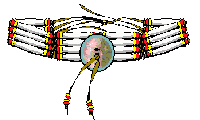 It's most often seen in large abalone-shell buttons. like the border, left, whose rainbow mother-of-pearl inner surfaces are used to center bone chokers, to hold braid wraps, and everywhere on all sorts of powwow outfits. It's most often seen in large abalone-shell buttons. like the border, left, whose rainbow mother-of-pearl inner surfaces are used to center bone chokers, to hold braid wraps, and everywhere on all sorts of powwow outfits.
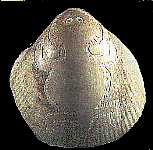 Hohokam etched-seashell horned toad was made sometime before 1100 AD. The Hohokam people -- ancestors of today's Tohono O'odham (Pima and Papago) nations -- flourished on the desert (see map) from around 300 AD to 1450. They introduced dryland corn cultivation, and had an extensive irrigation system, with hundreds of miles of canals, which were sited so well that the present-day cities of Phoenix and Tuscon superimposed new canals on the ancient system, for present use. They had a trade network with the peoples of northern Mexico and the gulf of California. They valued shells as ornaments, like this sea scallop. It has been etched by the same technique as modern lithography. Acid-proof pitch covered parts of the shell where raised design was to show and left uncovered the parts to be etched. The etching acid was fermented from a cactus sap, a unique technology. Hohokam etched-seashell horned toad was made sometime before 1100 AD. The Hohokam people -- ancestors of today's Tohono O'odham (Pima and Papago) nations -- flourished on the desert (see map) from around 300 AD to 1450. They introduced dryland corn cultivation, and had an extensive irrigation system, with hundreds of miles of canals, which were sited so well that the present-day cities of Phoenix and Tuscon superimposed new canals on the ancient system, for present use. They had a trade network with the peoples of northern Mexico and the gulf of California. They valued shells as ornaments, like this sea scallop. It has been etched by the same technique as modern lithography. Acid-proof pitch covered parts of the shell where raised design was to show and left uncovered the parts to be etched. The etching acid was fermented from a cactus sap, a unique technology.
These shells came mostly by diffusion trade. That is, unlike the parties of traders who came north from the Toltec empire to trade turquoise from the Anasazi, seashells were passed by the coastal tribes who got them to their inland neighbors. Who in turn passed some of them futher east. Almost 100 species of seashells have been found in the desert; of these, about 2/3 came from the Pacific ocean, the rest from the Gulf of Mexico coast, showing that trade was more common between the desert and California peoples.
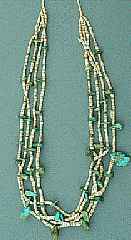 Heishi originally meant "shell" and soon came to refer to tiny shell beads like these white ones, which were made by hand around 1920 in a long Pueblo tradition. Today heishi (also made from stone, jet and turquoise) are made by hand only at Santo Domingo, a Rio Grande Keresan-speaking pueblo, where a few families -- such as Raymond Garcia of the Joe Garcia family -- maintain the tradition. Heishi originally meant "shell" and soon came to refer to tiny shell beads like these white ones, which were made by hand around 1920 in a long Pueblo tradition. Today heishi (also made from stone, jet and turquoise) are made by hand only at Santo Domingo, a Rio Grande Keresan-speaking pueblo, where a few families -- such as Raymond Garcia of the Joe Garcia family -- maintain the tradition.
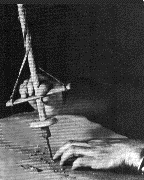 Shells (or soft stone) are broken into flat, irregular pieces. A hole is drilled into each one. Originally, a hand-pump drill, as shown in this old photo, was used. Pressing down on the bar causes the straps to unwind, turning the shaft, which in pre-contact days had a sharpened stone point, in more recent times a metal one. Since electricity came to the Pueblos in the 1970's, dentists' drills are used. Shells (or soft stone) are broken into flat, irregular pieces. A hole is drilled into each one. Originally, a hand-pump drill, as shown in this old photo, was used. Pressing down on the bar causes the straps to unwind, turning the shaft, which in pre-contact days had a sharpened stone point, in more recent times a metal one. Since electricity came to the Pueblos in the 1970's, dentists' drills are used.  In the old way, the beads -- jagged, irregular pieces which hadn't split when holes were drilled -- are strung and rolled on slabs of fine-grained sandstone, until they become disk shapes. (Mechanical sanders and buffers are now used.) The smaller the beads, the more work required to shape them. Many are lost -- split when drilling, broken or chipped while being sanded down. In the old way, the beads -- jagged, irregular pieces which hadn't split when holes were drilled -- are strung and rolled on slabs of fine-grained sandstone, until they become disk shapes. (Mechanical sanders and buffers are now used.) The smaller the beads, the more work required to shape them. Many are lost -- split when drilling, broken or chipped while being sanded down.
An even longer "trade route" is represented by the very popular pink coral heishi, which were introduced by the Spaniards in the 17th century. They have always come from Italy. No Indians have ever made coral heishi or other coral beads. Like glass beads they have always been European trade goods. Pinkish heishi in old necklaces found in archaeological sites are actually Caitlinite, pipestone, from the north. Imported coral heishi (and larger coral beads from Italy) remain very popular with necklace-makers, often mixed with turquoise, stone and shell.
Read about heishi -- how they are made, how to recognize good quality in necklaces for sale -- in this article prepared by Wingspread, a magazine for collectors of Indian art and artifacts.
Wingspread Heishi article.
Continue--Spirituality  | 
 The turquoise mosaic-covered seashell is similar to many found fully or partly covered with such tiny tiles in Anasazi ruins all over the southwest. The many strands of tiny beads are turquoise, and now are called heishi, which originally meant "shell." At left, is a type of seashell -- the Pacific Coast abalone -- we still use a lot today.
The turquoise mosaic-covered seashell is similar to many found fully or partly covered with such tiny tiles in Anasazi ruins all over the southwest. The many strands of tiny beads are turquoise, and now are called heishi, which originally meant "shell." At left, is a type of seashell -- the Pacific Coast abalone -- we still use a lot today.  It's most often seen in large abalone-shell buttons. like the border, left, whose rainbow mother-of-pearl inner surfaces are used to center bone chokers, to hold braid wraps, and everywhere on all sorts of powwow outfits.
It's most often seen in large abalone-shell buttons. like the border, left, whose rainbow mother-of-pearl inner surfaces are used to center bone chokers, to hold braid wraps, and everywhere on all sorts of powwow outfits. Hohokam etched-seashell horned toad was made sometime before 1100 AD. The Hohokam people -- ancestors of today's Tohono O'odham (Pima and Papago) nations -- flourished on the desert (see
Hohokam etched-seashell horned toad was made sometime before 1100 AD. The Hohokam people -- ancestors of today's Tohono O'odham (Pima and Papago) nations -- flourished on the desert (see  Heishi originally meant "shell" and soon came to refer to tiny shell beads like these white ones, which were made by hand around 1920 in a long Pueblo tradition. Today heishi (also made from stone, jet and turquoise) are made by hand only at Santo Domingo, a Rio Grande Keresan-speaking pueblo, where a few families -- such as Raymond Garcia of the Joe Garcia family -- maintain the tradition.
Heishi originally meant "shell" and soon came to refer to tiny shell beads like these white ones, which were made by hand around 1920 in a long Pueblo tradition. Today heishi (also made from stone, jet and turquoise) are made by hand only at Santo Domingo, a Rio Grande Keresan-speaking pueblo, where a few families -- such as Raymond Garcia of the Joe Garcia family -- maintain the tradition.  Shells (or soft stone) are broken into flat, irregular pieces. A hole is drilled into each one. Originally, a hand-pump drill, as shown in this old photo, was used. Pressing down on the bar causes the straps to unwind, turning the shaft, which in pre-contact days had a sharpened stone point, in more recent times a metal one. Since electricity came to the Pueblos in the 1970's, dentists' drills are used.
Shells (or soft stone) are broken into flat, irregular pieces. A hole is drilled into each one. Originally, a hand-pump drill, as shown in this old photo, was used. Pressing down on the bar causes the straps to unwind, turning the shaft, which in pre-contact days had a sharpened stone point, in more recent times a metal one. Since electricity came to the Pueblos in the 1970's, dentists' drills are used.  In the old way, the beads -- jagged, irregular pieces which hadn't split when holes were drilled -- are strung and rolled on slabs of fine-grained sandstone, until they become disk shapes. (Mechanical sanders and buffers are now used.) The smaller the beads, the more work required to shape them. Many are lost -- split when drilling, broken or chipped while being sanded down.
In the old way, the beads -- jagged, irregular pieces which hadn't split when holes were drilled -- are strung and rolled on slabs of fine-grained sandstone, until they become disk shapes. (Mechanical sanders and buffers are now used.) The smaller the beads, the more work required to shape them. Many are lost -- split when drilling, broken or chipped while being sanded down.